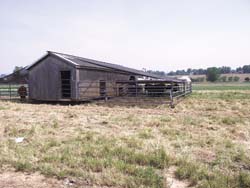Solar-Powered Shaded Cow "Tractor"

Nelson Nolt built the ultimate intensive grazing system for his pasture-fed beef. A solar-powered winch pulls a 40 by 54-ft. grazing pen across the field. Nolt's cattle are even sheltered from thunderstorms or hot sun. The pen is suspended from a 14 by 40-ft. wood frame shed that steers like a wagon when it's time to go the other way.
"The shed and paddocks to either side hold up to 30 head," says Nolt. "The shed holds mineral, salt and a water tank. It moves to fresh ground once an hour." How far it moves depends on the quantity and quality of forage available. If it's moving across 4-ft. tall sorghum, it may move only a few feet at a time. If it's in 12 to 15-in. hay, each move may be the length of the building. Nolt simply sets a timer to control how long the solar-powered winch operates. The winch and its solar panel mount to a 2,000-lb. block of concrete that Nolt moves as needed. Once in place, he feeds out the 250-ft. cable and attaches it to the wagon-like hitch at the front of the shed.
The shed and gates ride on six 12 by 26 wheels, with 4 at the rear and 2 up front. The rear axles are mounted underneath the shed frame with a wheel on either side of the frame, about 12 ft. from the rear corners.
The front axles pivot on frameworks inside of each shed wall. The wheels are linked only by a tie rod that's attached to the hitch on front of the shed.
"When I get to the end of the field, I hook the tractor on in place of the winch and pull the shed into place for the next swath of grazing," explains Nolt. "The hitch and front wheels work like front wheels on a wagon."
The shed with its suspended gates is an engineering marvel. It uses both a cantilevered support beam with anchoring cables for rigidity and roof top suspension cables that do double duty supporting shade cloth and paddock fence line.
The 14-ft. wide shed has a 20-ft. wide paddock on each side. The paddocks run the full length of the 40-ft. building. The 20-ft. steel pipe gates at either end of the paddocks are mounted to the corners of the shed with small swivel wheels mounted at outside corners. Pipe panels. "The swivel wheels help the gate ride over rough ground," says Nolt.
"Quarter-inch support cables run from the ends of the 20-ft. panels back to the ridge of the roof."
The main support for the paddock fencing, and in particular the 40 ft. of side panels, is a 2 by 12-ft. beam. It mounts above full-grown animal height to the frame of the shed and extends out from either side by 20 ft. A single 5/16-in. cable from the peak of the shed runs to either end of the beam. To reduce twisting, two 3/16-in. cables stretch from the end peaks of the shed to either side of the 2 by 12-in. beam. One set connects with the beam at a point about 6 ft. from the shed. The second set connects at about 12 ft. Nolt drew the plans for his mobile grazing shed over the course of several years. He contracted with a local builder to construct it. He also turned to a local solar panel installer for an appropriate panel and storage batteries for the 1/2 hp winch.
"I needed enough power for the winch to operate for several cloudy days," says Nolt. "So far it has worked fine."
Pasturing is done on one of three 20-acre strips. He rotates the strips through intensive grazing, corn and mixed vegetables. He plants the pastured strip to multiple types of forage for season long grazing. Worn out hay ground gets no-till seeded to oats for late season grazing. Nolt also uses solar power to ensure the cattle always have fresh, cool water. He has buried water lines for irrigating the vegetables and watering the cattle. He runs a 3/16-in. hose from the nearest riser to the water tank mounted inside the shed. If water in the line starts to heat up, a temperature sensor at the tank will override the float and keep water flowing.
"I found with larger hoses that the water heated up too much in the sun when it wasn't running," explains Nolt. "I have a 55-watt panel with a 12-volt battery to power a booster pump at the riser. It pushes the water through the line faster so it stays even cooler." Nolt has timers set on the winch to move the grazing shed from near sunrise to near sunset. The cattle quickly learn when fresh ground will be appearing.
"When they hear the cable start to tighten up, they line up shoulder to shoulder to get the fresh graze," says Nolt.
